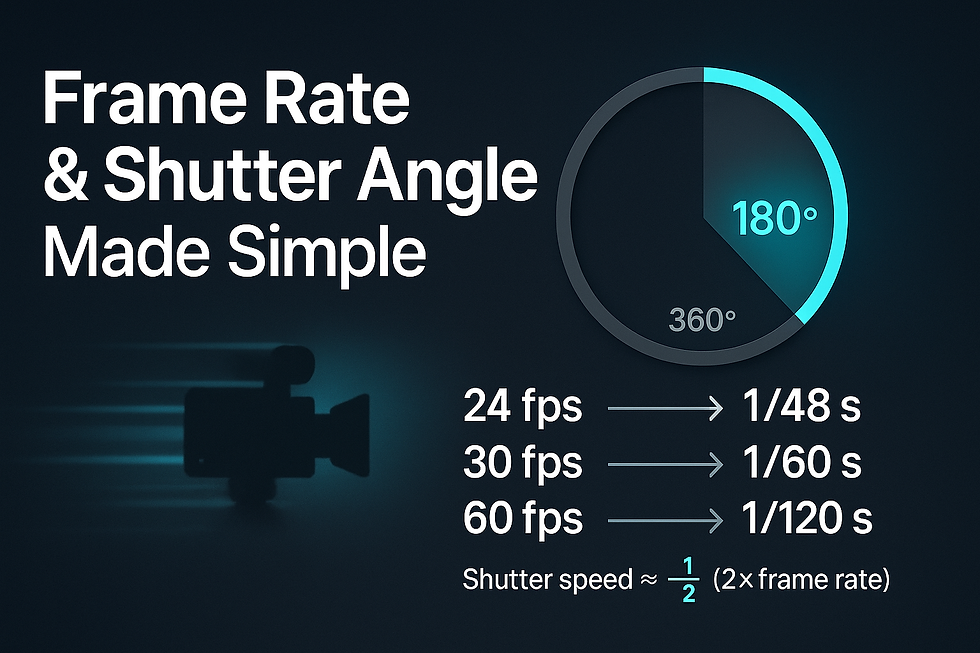Frame Rate & Shutter Angle Made Simple
- Webmaster
- Sep 6
- 4 min read

Shutter Angle and Frame Rate at a Glance
Cinematic look: set 180° shutter angle.
Shutter speed formula: Exposure time TTT in seconds = Shutter angle ÷ (360 × Frame rate).Example at 24 fps with 180°: T=180÷(360×24)=1/48T = 180 ÷ (360 × 24) = 1/48T=180÷(360×24)=1/48 s.
Flicker safety: in 60 Hz regions use shutter speeds like 1/60, 1/120, 1/240. In 50 Hz regions use 1/50, 1/100, 1/200.
Break the 180 rule for a reason: sharper action at 90°, dreamy blur near 270° to 360°.
What these terms mean
Frame rate (fps): how many frames you capture or play per second. Shutter angle: the fraction of the frame period that the sensor gathers light. A 360° angle means the shutter is effectively open for the full frame period. 180° means half the frame period, which gives natural motion blur.
Many cinema cameras let you pick shutter angle. Most mirrorless cameras default to shutter speed. They are two ways to describe the same thing.
Conversions
Exposure time TTT = Shutter angle ÷ 360×fps360 × \text{fps}360×fps
Shutter angle = 360×fps×T360 × \text{fps} × T360×fps×T
Shutter speed is just 1/T1/T1/T
The 180° rule, and why it works
At 180°, your exposure time is half the frame period. That balance creates motion blur that feels natural to our eyes.
24 fps at 180° → 1/48 s
30 fps at 180° → 1/60 s
60 fps at 180° → 1/120 s
This is the fastest way to get a cinematic baseline without overthinking it.
Quick recipes for common frame rates
Use these as starting points. Round to the nearest standard shutter speed your camera offers.
Frame rate | 180° shutter | 90° (crisper) | 360° (dreamier) |
23.976 | 1/48 (or 1/50) | 1/96 | 1/24 |
24 | 1/48 | 1/96 | 1/24 |
25 | 1/50 | 1/100 | 1/25 |
29.97 | 1/60 | 1/120 | 1/30 |
30 | 1/60 | 1/120 | 1/30 |
50 | 1/100 | 1/200 | 1/50 |
59.94 | 1/120 | 1/240 | 1/60 |
60 | 1/120 | 1/240 | 1/60 |
100 | 1/200 | 1/400 | 1/100 |
120 | 1/240 | 1/480 | 1/120 |
Tip for 23.976: many cameras only offer 1/48 or 1/50. Either is fine. Pick 1/50 if you need 50 Hz flicker safety.
How to avoid LED and mains flicker
Most LED fixtures and building lights sync with the power grid.
USA and most of the Americas: 60 Hz. Use 1/60, 1/120, 1/240.
Europe, many parts of Asia and Africa: 50 Hz. Use 1/50, 1/100, 1/200.
If you must shoot 24 or 30 fps under 50 Hz lights, prefer 1/50 or 1/100 and nudge ISO or aperture to compensate. For high-fps slow motion, keep shutter a clean multiple of the local mains frequency.
When to break the 180° rule
Fast action or sports: go 90° or 120° for crisp motion and easier frame grabs.
Low light: open up to 270° or 360° to collect more light, knowing blur will increase. Use this for slow, moody shots or interviews where the subject is still.
Staccato style: 45° gives the iconic choppy look seen in intense action sequences. Use sparingly.
Slow motion that still looks cinematic
If you record at 60 fps for a 24 fps timeline, keep capture shutter near 1/120. When you slow the footage, the motion blur still feels natural.
120 fps capture → start at 1/240
240 fps capture → start at 1/480
Exposure triangle, ND, and shutter choices
Shutter Angle and Frame Rate at a Glance. Shutter angle affects exposure. If you change shutter to fight flicker or to stylize motion, you must rebalance with aperture, ISO, or ND filters.
Want shallow depth of field outdoors but need 1/50 for 25 fps flicker safety. Add ND 4 to ND 8 so you can keep the aperture wide.
Running and gunning at events. Lock shutter for cadence, ride auto ISO within a safe range, and use ND as the light changes.
Rolling shutter and motion blur are different
Rolling shutter is sensor readout skew. Shutter angle controls exposure time and blur.
A faster shutter (90°) reduces blur but does not remove skew.
To fight skew, stabilize your rig, pan slower, or use a camera with faster readout.
Practical setup steps
If your camera shows shutter angle
Pick your frame rate.
Set 180°.
Adjust aperture, ISO, and ND for exposure.
If you see flicker, try 172.8° at 24 fps for 50 Hz regions, or jump to a mains-friendly speed like 1/50.
If your camera only shows shutter speed
Pick your frame rate.
Dial the closest 180° value from the table above.
If lights flicker, switch to the nearest mains-friendly speed and rebalance exposure.
Troubleshooting speed guide
Banding in the shadows: raise shutter to a mains-friendly value, or dim the offending lights, or switch lights off and use your own.
Motion looks smeary: lower shutter angle to 144° or 90°.
Strobing on fine patterns: avoid extremely fast shutter unless the look is intentional.
Jitter on slow pans at 24 fps: pan slower, add foreground parallax, or shoot 30 fps if delivery allows.
Mini FAQ
Is 23.976 different from 24.00?Yes. Use 1/48 for both, or 1/50 if you need 50 Hz safety.
Can I shoot 60 fps and deliver 60 fps for sports? Yes. Keep shutter near 1/120 for natural blur. Go 1/240 for extra crispness.
Do phones follow the same rules? Yes. Many phones now offer manual frame rate and shutter. Use the same recipes.

Copy-ready presets
Cinematic interview, 24 fps: 24p, 180°, ISO to taste, ND for aperture control.
YouTube talking head, 30 fps: 30p, 180° → 1/60, adjust lights for flicker-free scene.
Gym or court highlights, 60 fps: 60p, 120° to 180°, higher ISO, fast glass.
B-roll slow mo, 120 fps: 120p, 180° → 1/240, oversample for clean grade.









Comments